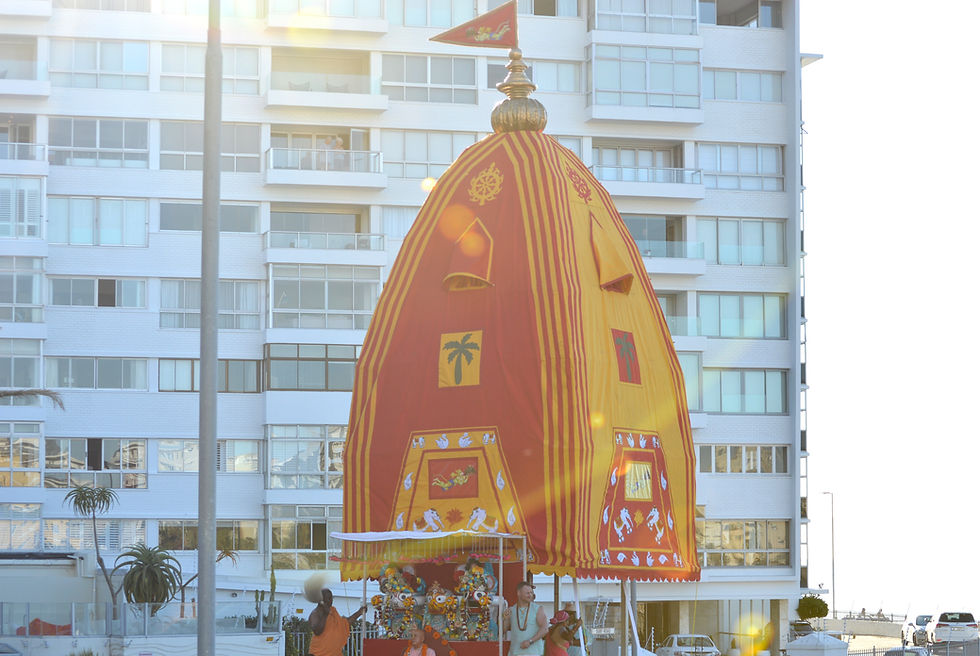Jagannath Rath Yatra: A Sacred Journey of Devotion and Unity
- Shreya Giri
- Jul 10
- 5 min read
The Jagannath Rath Yatra, one of the most celebrated and vibrant festivals of India, holds immense spiritual and cultural significance. Rooted in the ancient temple town of Puri, Odisha, this grand chariot procession is a centuries-old tradition that symbolizes devotion, divine love, inclusivity, and unity. Celebrated annually in the month of Ashadha (June-July), the festival marks the ceremonial journey of Lord Jagannath, along with his siblings Balabhadra and Subhadra, from their main abode- the Jagannath Temple, to the Gundicha Temple. Millions of devotees, irrespective of caste, creed, or nationality, gather in Puri to witness this divine spectacle.

The term "Jagannath" means "Lord of the Universe," derived from the Sanskrit words "Jagat" (universe) and "Nath" (lord). According to Hindu beliefs, Lord Jagannath is a form of Lord Vishnu or Krishna, worshipped predominantly in Odisha but also revered across India and abroad. The Rath Yatra (Chariot Festival) commemorates the annual journey of Lord Jagannath to his aunt’s temple, the Gundicha Temple, located 3 kilometers from the main Jagannath Temple in Puri.
The origin of this festival is linked with numerous legends from the Puranas and local folklore. One popular legend suggests that Lord Jagannath desires to visit his birthplace, Vrindavan, once a year to relive his childhood memories. The Gundicha Temple is metaphorically considered as Vrindavan. The Rath Yatra is also said to signify Krishna's journey from Gokul to Mathura, symbolizing the cycle of life, death, and rebirth.
Historically, the tradition of Rath Yatra in Puri dates back to the 12th century during the reign of King Anantavarman Chodaganga Deva of the Eastern Ganga Dynasty, who built the Jagannath Temple. Over time, the festival has grown in scale, drawing devotees and tourists from around the world.

The three principal deities-Lord Jagannath, Balabhadra (his elder brother), and Subhadra (his younger sister), are placed in three grand, artistically decorated wooden chariots, each with distinct names, designs, and symbolic meanings:
Nandighosha (Jagannath’s Chariot)
Height: 45 feet
Wheels: 16
Taladhwaja (Balabhadra’s Chariot)
Height: 44 feet
Wheels: 14
Darpadalana (Subhadra’s Chariot)
Height: 43 feet
Wheels: 12
The chariots are constructed anew every year using wood from specific trees like phassi, dhaura, and others, brought from designated forests by temple carpenters known as “Maharanas.”

The Rituals and Sequence of Events
The Rath Yatra is a nine-day event filled with various intricate rituals and ceremonies. It begins with Snana Purnima, the bathing festival, followed by Anasara, during which the deities fall "ill" and remain out of public view for 15 days. The Yatra officially begins on the Dwitiya Tithi of Ashadha Shukla Paksha.
Chhera Pahara: The most iconic ritual is "Chhera Pahara" (sweeping of the chariots), performed by the Gajapati King of Puri, who sweeps the chariot platforms with a golden broom while sprinkling sandalwood water. This act symbolizes that even the highest mortal authority is a servant before the divine.
Pulling the Chariots: Once the deities are seated on their respective chariots through the ceremonial procession called "Pahandi," lakhs of devotees pull the massive ropes of the chariots with great enthusiasm. The movement of these rathas through the Grand Road (Bada Danda) is accompanied by chants, hymns, drums, cymbals, and dances, creating an atmosphere of divine ecstasy.
Stay at Gundicha Temple: Upon reaching the Gundicha Temple, the deities stay for seven days. This is known as the "Gundicha Yatra." During this time, devotees can get closer darshan of the deities in a more informal setting than the strict rituals of the main temple allow.
Hera Panchami: On the fifth day, Goddess Lakshmi visits the Gundicha Temple in search of her consort Lord Jagannath and expresses her displeasure for leaving her behind. This humorous and symbolic ritual portrays the divine drama within the family of gods.
Return Journey – Bahuda Yatra:After the sojourn, the return journey, called "Bahuda Yatra," takes place, marking the return of the deities to the main Jagannath Temple.
Suna Besha and Niladri Bije: On the day after the return, the deities are adorned with gold ornaments in a ritual called “Suna Besha.” Finally, the deities re-enter the sanctum sanctorum in a ceremony known as “Niladri Bije,” marking the end of the Rath Yatra.

The Philosophical and Cultural Dimensions
The Jagannath Rath Yatra is not just a religious procession but a vivid representation of Hindu philosophy, particularly Vaishnavism. Lord Jagannath is worshipped in a non-anthropomorphic form, his wooden body with large round eyes, stumps for hands and feet, and a dark complexion represents universality, timelessness, and the incomprehensibility of God.
Culturally, the Rath Yatra is a festival of inclusion. People from all walks of life, regardless of caste, creed, gender, or nationality, Participate in the festival, reinforcing the idea of “Sarva Dharma Sambhava” (equal respect for all religions). Even non-Hindus, who are otherwise not allowed into the sanctum of the Jagannath Temple, can see the deities during the Yatra.
Global Influence and Celebrations Abroad
With the global spread of the International Society for Krishna Consciousness (ISKCON), the Rath Yatra has crossed Indian borders and is celebrated in over 100 cities worldwide, including London, New York, Moscow, Johannesburg, and Melbourne. These international Rath Yatras follow similar traditions, with the deities seated on elaborately decorated chariots, devotional songs, dances (kirtans), and free food distribution (prasadam).
Jagannath Culture: A Unique Civilizational Identity
The cult of Lord Jagannath is distinct in its symbolism, traditions, and iconography. The deities are made of neem wood (called "Daru"), and every 12 to 19 years, a grand ritual called Nabakalebara (new body) is held, where the deities are replaced with newly carved idols from sacred trees. The old idols are ceremoniously buried inside the temple premises, indicating the cyclic nature of life and death.

The Mahaprasad of Jagannath, cooked in earthen pots and offered in the world’s largest kitchen (Ananda Bazaar), is another marvel of this tradition. It serves as a reminder of communal harmony as people of all castes and communities partake in it together.
Conclusion
The Jagannath Rath Yatra is a living tradition that transcends time, geography, and societal boundaries. It is not merely a procession but a sacred journey that exemplifies devotion, equality, and spiritual awakening. As the chariots roll down the Grand Road of Puri every year, they carry not just deities but the aspirations, hopes, and faith of millions. In a world divided by materialism and strife, the Rath Yatra stands tall as a symbol of unity, humility, and divine love, where the lord steps out of his temple to meet his devotees, making the divine accessible to all.

About the Author
Shreya Giri is a talented SEO content writer with a unique flair for captivating readers. With a master's degree in geography, her passion for crafting exceptional content shines through in every word she writes. Shreya's expertise lies in her ability to seamlessly blend language and storytelling, effortlessly capturing the attention of her audience.
She is pursuing a Master's degree in geography and has a remarkable talent for transforming intricate concepts into captivating narratives that have a lasting impact. With Shreya, you can expect excellent, compelling content that will keep you engaged from beginning to end.
You can connect with her through-
My-Lekh profile- https://www.my-lekh.com/profile/shreyagiri3008/profile
LinkedIn profile- https://www.linkedin.com/in/shreya-giri-a0a607265
Email- shreyagiri3008@gmail.com





Comments